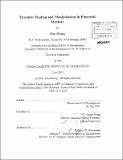| dc.contributor.advisor | Jiang Wang. | en_US |
| dc.contributor.author | Huang, Kan, Ph. D. Massachusetts Institute of Technology | en_US |
| dc.contributor.other | Sloan School of Management. | en_US |
| dc.date.accessioned | 2012-01-30T17:06:15Z | |
| dc.date.available | 2012-01-30T17:06:15Z | |
| dc.date.copyright | 2011 | en_US |
| dc.date.issued | 2011 | en_US |
| dc.identifier.uri | http://hdl.handle.net/1721.1/68962 | |
| dc.description | Thesis (Ph. D.)--Massachusetts Institute of Technology, Sloan School of Management, 2011. | en_US |
| dc.description | Cataloged from PDF version of thesis. | en_US |
| dc.description | Includes bibliographical references. | en_US |
| dc.description.abstract | Chapter 1 studies how asset managers, due to reputation concerns, manipulate performance through taking latent risk dynamically. It is found that both skilled and unskilled managers load on excessive level of latent risk to boost performance even if investors are fully rational. The equilibrium risk taking by managers has interesting implications on investors' evaluation of manager's skill under normal market conditions and upon crash. Excessive risk taking reduces welfare of investor as well as unskilled managers, which calls for the presence of diligent third-party monitoring. Time required by investors to discover a manager's ability is also significantly lengthened. Our model yields several unique predictions about crash losses, which are supported by empirical analysis using hedge fund data. Besides, it provides complementary explanations for declining returns of large funds and the high demand for structured mortgage securities before the subprime mortgage crisis. Chapter 2 investigates price manipulation in general equilibrium with the only market imperfection being the presence of a non-competitive large trader. We propose the notion of "pure manipulation", in which the large trader manipulates security prices to improve-her welfare but supported by no genuine trading motive. The existence of pure manipulation is equivalent to the failure of the Weak Axiom of Revealed Preference of aggregate security demand at the competitive equilibrium. We state conditions that prohibit pure manipulation. We also demonstrate that heterogeneity in preferences and endowments, large trading needs and remaining insurance demand in the competitive equilibrium could lead to a jointly upward-sloping portfolio demand, which gives rise to pure manipulation that requires arbitrarily small capital commitment. In addition, we establish a link between static and multi-period manipulation and show that dynamic trading reduces manipulation power. Different security structures that complete the markets lead to different equilibrium allocations in the presence of a non-competitive trader. Chapter 3 analyzes how a risk-averse large institutional investor with price impact trades dynamically in the presence of momentum traders. The larger investor engages in several interesting manipulative behaviors. She may conduct "round-trip" trades to profit from momentum sentiment. She may buy (sell) before planned large sale(purchase) to manipulate intertemporal demand. In addition, she takes profit less aggressively to let the momentum sentiment last longer. Besides, with endogenously generated price impact, we find that higher price volatility does not lead to faster execution. | en_US |
| dc.description.statementofresponsibility | by Kan Huang. | en_US |
| dc.format.extent | 148 p. | en_US |
| dc.language.iso | eng | en_US |
| dc.publisher | Massachusetts Institute of Technology | en_US |
| dc.rights | M.I.T. theses are protected by
copyright. They may be viewed from this source for any purpose, but
reproduction or distribution in any format is prohibited without written
permission. See provided URL for inquiries about permission. | en_US |
| dc.rights.uri | http://dspace.mit.edu/handle/1721.1/7582 | en_US |
| dc.subject | Sloan School of Management. | en_US |
| dc.title | Dynamic trading and manipulation in financial markets | en_US |
| dc.type | Thesis | en_US |
| dc.description.degree | Ph.D. | en_US |
| dc.contributor.department | Sloan School of Management | |
| dc.identifier.oclc | 773929999 | en_US |
